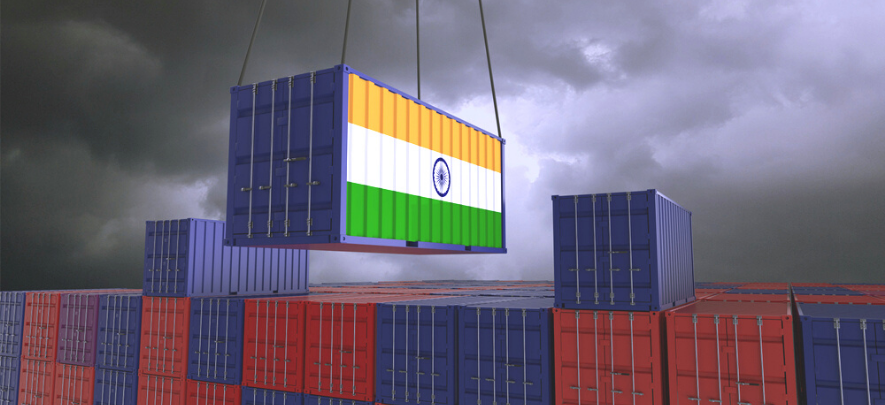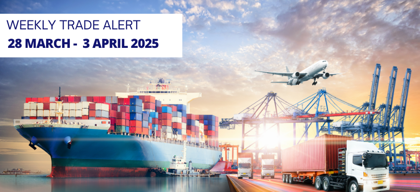India's Foreign Trade: Global challenges, policy parameters and the way forward during such difficult times

Export Sector
Federation of Indian Export Organisations
197 week ago — 15 min read
The Federation of Indian Export Organisations (FIEO) recently organised an online press interaction on India's foreign trade and here are the main highlights.
India’s Exports
India’s exports growth has been quite encouraging in the last few months despite the country facing the second wave of pandemic.
However, FIEO analysis of trade data of the last 5 years (calendar year 2016 to calendar year 2020), based on the figure of UN Comtrade, points to some of the areas of concern and some extremely positive emerging scenario.
The global imports grew at a CAGR of 3% during 2016-2020 while our exports at 2% only. However, since our exports have taken a huge hit due to lockdown for few months in 2020, the CAGR of India’s exports over 5 year period including 2020 was pulled down and the same explanation, to some extent, also applies to global imports in 2020.
1. Many of the labour-intensive sectors, contributing sizeably to our exports, are constantly losing their share in global market. The exports growth, in these labour-intensive sectors, has been less than the growth in global imports. To substantiate the above point, let us corroborate with the following:-
a. In the Gem & Jewellery sector, global imports in the last 5 years grew by the Compound Annual Growth Rate (CAGR) of 5% during 2016-2020. However, India’s exports, during the same period, contracted by a CAGR of 12%.
b. Similarly, the Woven Garment imports globally remained static during 2016-2020, while our export of woven garments contracted by a CAGR of 8% in the same period. Even in Knitted Garments, global imports remained stagnant whereas India’s exports of knitted garments contracted by 6% during 2016-2020.
c. In the Leather Footwear sector, in which global imports grew by a CAGR of 1% during 2016-2020, our exports contracted at a CAGR of 7% only. Similarly, in other leather goods sector including saddlery, leather bags, purses, belts, etc., the global imports remained static while India’s exports of such products contracted by a CAGR of 4%.
However, in the Labour-Intensive sector of sports goods and toys, while the global imports witnessed a CAGR of 3% during 2016-20, India’s exports clocked a CAGR of 9 %. But, our exports, in the global imports of US$ 120 billion, was just about US$ 380 million, less than 0.35%. In furniture and beddings, while the global imports witnessed a CAGR of 2% during 2016-20, India’s exports clocked a CAGR of 9 %.
These sectors are extremely important both from the perspective of exports and job creation. Therefore, a more focused approach to the problem faced by the sectors may be required. A stakeholder’s consultation of the sectors may throw some light on the challenges and competition faced by them so as to evaluate and address them.
2. There are sectors which have performed exceedingly well in the last 5 years and continued to be on a growth trajectory, yet they have tremendous potential to push exports further. Some of these sectors are:
a. The Mechanical Machinery and Parts thereof (Chapter-84) showed a CAGR of 3% in global imports during 2016-20. However, India’s exports of the said products grew by a CAGR of 8% in the same period. Despite having such growth, our share, in the segment, is still less than 1% (our exports stood at US$ 18 billion in 2020 where the global market size is over US$ 2142 Billion.
b. In the Electrical and Electronic segment, global imports grew at a CAGR of 4% during 2016-2020 to a market size of US$ 2900 billion, whereas India’s exports went up at a CAGR of 16%. Needless to say that in this segment, India’s share is little over 0.5% indicating a long way to go to achieve the potential.
c. In the Medical & Surgical equipment sector, global imports grew at a CAGR of 3% during 2016-20, whereas India’s exports grew at a CAGR of 5% in the same period.
d. In many of the Agriculture related sectors including coffee, tea, spices, preparation of meat & fish, preparation of foods & vegetables, India’s CAGR in exports has been more than the double the CAGR of global imports. In coffee, tea, spices, while global imports grew at a CAGR of 1% during 2016-20, India’s exports grew at a CAGR of 4%, in preparation of fish and meat products, global imports grew at a CAGR of 4% during 2016-20 our exports grew at a high CAGR of 17%. Similarly, in preparation of foods and vegetables, while global imports grew at a CAGR 3% during 2016-20, India’s exports grew at a CAGR of 6%.
Since many of these segments are covered under the Production Linked Incentive (PLI) Scheme, we are expecting expansion of capacity to build the necessary base of exports in the country. Some of these can be classified as winner sectors and the sheer market size in many of these segments requires a very close look at them to increase exports by over US$ 100 billion in a very short time of less than 5 years.
Request to the Government
Cost of Credit
Despite reduction in the interest rates, the cost of credit to Indian Exporters is much high as compared to their competitors. The Interest Equalisation Scheme (IES) has provided competitive credit to manufacturer in MSME and exporters of products covered in 416 specific tariff lines. The IES scheme is valid only till 30th June, 2021. We request the Government to extend the IES scheme till 31st March 2024.
Liquidity
The delays in refunding exports benefit has further squeezed the liquidity of exporters. These include:
(a) Delay in Notifying RoDTEP Rates
In the absence of the Rates, exporters are perplexed as to how they compute the benefit in the Scheme for quoting for new orders. Many exporters have hold negotiation of orders which may have an adverse bearings on export growth. The liquidity of exporters have also been affected as they could not get refund for exports made from 1st January, 2021 onwards. RoDTEP rates may be notified instantly.
(b) Blockage of MEIS Portal for Apr-Dec, 2020
In the competitive international market, exporters are finalizing export orders taking into consideration the export benefits they are eligible for. Delay/denial of such benefit at later stage put the exporters in great loss and they face acute liquidity crunch in execution of fresh export orders. The MEIS benefits for Apr-Dec, 2020 may be released to exporters as they are facing tough times due to pandemic.
(c) Delay in SEIS Rate Notification
Eligible service exporters are still to get the benefit for the financial year 2019-20 and 2020-21 as there is no clarity on the Scheme and the rates. Many of the services like the hospitality sectors are the worst victim of pandemic and need immediate support by release of long due entitlement. SEIS benefits for 2019-20 may be released and SEIS rates for 2020-21 may be announced soon.
(d) Capital Blockage of Exporters tagged as “Risky”
Such established but categorized as risky exporters (particularly MSMEs) are suffering irreparable loss. In the case of many exporters, they have been procuring export goods from large number of suppliers/manufacturers/stockists/dealers and getting each and every supplier verified is a long-drawn process. The SOP issued by CBIC with regard to the timelines are not being adhered to. In order to provide relief to such so called “risky” exporters, the legitimate refund should be released, if necessary, on an undertaking.
(e) Amendment in Section 16(3) of IGST Act relating to refund:
Withdrawing the IGST Refund facility on exports, without any application will be great set back to exporters as claiming there fund through ITC route is cumbersome, time consuming and increase transaction cost. We request the Government that the optional facility both of IGST refund and ITC refund continues particularly as IGST refund mechanism is more efficient, transparent and completely automated with no human intervention.
Infrastructure
Infrastructure is extremely important to provide competitiveness to exports as it influences both the production cost and logistics cost. Many studies have revealed that Indian manufacturing is one of the most competitive as far as costs within the factories are concerned but we are outpriced owing to costs beyond factories. Our logistics cost is about 14% of GDP as against 8% in the US and 10% in EU countries. The cost of carrying a container from the hinterland in UP or Punjab to Nhava Sheva port in Mumbai works out to be more than carrying it to many European destinations, barring the pandemic period. The high logistic cost is one of the important reasons for depriving the country to be part of global value chains or linkage with international production centres. While general spending on infrastructure is on the rise, we require increase spending on exports related infrastructure including land customs, ICDs, Testing and Certification facility, Bazzar Haat on international land borders etc.
Solution
Higher allocation of Fund to TIES: To support export infrastructure, we have a dedicated scheme known as Trade Infrastructure Exports Scheme (TIES), which replaced the erstwhile ASIDE Scheme. The budget allocation for the scheme in 2021-22 is only Rs 75 Cr. How can we support infrastructure development for exports in 28States and 8 UTs with a meagre sum of Rs 75 Cr? While we appreciate the challenges faced by the Government during the pandemic but such a paltry sum that too for infrastructure is grossly inadequate and should be increased to Rs 1000 Cr to serve the intended purpose.
Container shortage
Logistics infrastructure has been under severe pressure since the beginning of the pandemic. The container shortage, non-availability of vessels and high container freight have affected exports as well as profitability of exporters .The situation was slowly reverting to close to normal before the second wave but it has again aggravated. The waiting time to get a container is now again increased to 10-20 days and instant availability attracts over 100% premium. The demand-supply mismatch has encouraged few stakeholders to put regular bookings on hold, for one reason or the other, and allocate containers to those who are paying premium.
Solution
(a) We need to put our focus on container manufacturing as mismatch between exports/imports may continue, particularly as we focus on Aatma Nirbhar Bharat and PLI Scheme. Moreover, we require containers for coastal shipping. One estimate puts it around 60000 in the next 5 years. Government is developing Bhavnagar and Kutch for container manufacturing, Transworld Dubai has signed an MoU with Sagarmala Development Corporation Limited to invest Rs 200 Cr in container manufacturing. Public sectors and Private sectors have shown interest in it and few have started manufacturing containers. (b)There is a need to release containers, which have been held up or detained by various authorities as their numbers are also close to 50000.
Exorbitant hike in freight charges
The freight rates have skyrocketed from the pre pandemic period. A 40-feet container to the United States before Covid was costing US$2,000, now it is priced between US$6,200 and US$6500. Similarly, for Europe the cost was US$1,200-US$1500 earlier, which has gone up to US$ 5,500. The freight rates increase to West Africa and many destinations has gone up by 500-600% in the last one and half year affecting the profitability of exporters particularly those quoting on CIF, C&F and other delivery terms which include freight.
Solution
While freight increase is a global phenomenon, we may be suffering more as we have a fairly large MSMEs in exports, who have very less negotiating power. We require an Indian Shipping Line of global repute in the country. We have only the Shipping Corporation of India, having a market share of less than 5% of our total shipping business, which is also being disinvested. We require a large shipping company in India as we remit about US$ 65 Bn every year as the transport charges overseas and yet remain at the mercy of foreign shipping lines. As we move towards a trillion dollar of exports, the remittance for freight will touch US$100 Bn. If the Indian shipping lines get 25% of the business, we have a captive market of over US$25 Bn waiting. The Government may provide some fiscal support either through liberal lending or through tax benefits to facilitate the same.
Commodity boon and exports
The commodity prices have started rising in 2020 and the same is continuing in 2021. Such increase in the prices has its pros & cons for Indian exports. While on the one hand, it has resulted in positive exports of these products, despite lock down and supply chain disruption during 2020. However, at the same time, it has added to the problem of downstream industry as many of them are facing the brunt with hike in prices particularly in exports as buyers are not willing to provide proportionate increase in the prices of final products. This has affected the profitability of exports, which is at a record bottom today. While commodity exports are important, we should look at how we can convert at least some of these exports into value added exports. Government should encourage the downstream industry in such sectors so that more domestic capabilities are created for manufacturing/processing and exports of products manufactured. Secondly, commodity exports help our competitors as they get access to our raw material and with economies of scale, manufacture the end product at a very competitive cost.
Moreover, commodity exports put an additional burden on logistics as in some cases the same raw material is exported by one company and imported by another in the country. Thus the country is losing freight on both sides. It also further aggravates the problems of containers which are much in short supply. Regular dialogue between commodity exporters and downstream producers can be helpful so as to strike a balance between exports and domestic availability.
Read the full press release here.
Also read: FIEO Niryat Shree & Niryat Bandhu Awards: Call for nominations
Image source: shutterstock.com
Disclaimer: The views and opinions expressed in this article are those of the author and do not necessarily reflect the views, official policy or position of GlobalLinker.
Posted by
Federation of Indian Export OrganisationsFIEO is the apex international trade promotion organisation of India. Directly and indirectly it represents the interest of over 200,000 exporters in India. FIEO has 17 offices in...
Network with SMEs mentioned in this article
View Federation of Indian 's profile
Most read this week
Trending













Comments (2)
Share this content
Please login or Register to join the discussion